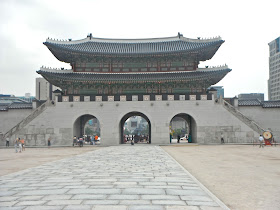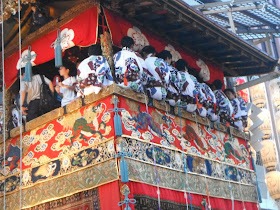I'm standing on the subway in Seoul, awkwardly clutching the hand ring, and trying not to make eye contact with the old man sitting down in front of me, who is, for some reason, staring pointedly at me. He says something in Korean. I smile apologetically and ignore him. He tries again, more urgently. This time he begins making strange hand gestures. He is rubbing at his crotch furiously and grunting out words I don't understand. Then he points at
my crotch, gabbering away and moving his fingers up in a sliding motion. What? Mortified, I look down. Oh. My fly is undone. I deal to the problem, and the old man chuckles, and sits back, satisfied.
This, I thought to myself, would never happen in Japan.
During my three day trip to Seoul - barely a two hour flight away - I experienced a glorious culture shock whirlwind of language, food, people and culture. It all happened at once. Less than two weeks ago, Ryan, one of our friends and I decided spontaneously to go to Korea. We bought cheap flights on the new budget airline Peach, booked accommodation on Hostelworld.com, and armed ourselves with the Lonely Planet Seoul travel guide and a 'Survival Korean' language book. Then we were off.
Walking through Hongdae, the university district where we were staying, at midnight on the Wednesday night we arrived, I was surprised to see almost everything was still open, and people were everywhere. Neon lights with hangul characters twinkled invitingly, rainbow-coloured pamphlets advertising clubs, restaurants and shows littered the ground. The smell of barbecued meat and kimchi wafted outside through open doors, followed by the sweet scent of squeezed lemons as we walked past one of the many lemonade stands dotted around the nighttime streets.
The people were open, too. Young couples walked around holding hands, making out, not caring who was watching. Crossing busy roads, people weren't afraid to touch you, in order to jostle past. The older men and women working the street vendor stalls gossiped away as they stirred big, bubbling pots of orange topogi, and twirled sticks of vegetables and hot dogs into vats of oil. As we lined up for a hot dog, the woman at the stand used her spoon to nonchalantly fish a hair out of the topogi pot. It didn't seem to matter.
 |
| Night scenes in Hongdae |
 |
| Sipping on homemade lemonade served in a plastic bag. |
It was three days filled with shopping. We saw the workings of Seoul's famous markets, Namdaemun and Dongdaemun, with their mazes of streets and stalls selling all sorts of treasures. Ryan took up haggling as a sport. The reaction would always be the same - the salesperson would give a long, pained sigh, and glare, before pulling out a calculator and typing out the new price. I guess you have to be careful not to rip them off too much - at Namdaemun, we saw two Korean men get into a loud fist fight over a pair of women's underwear, which attracted a curious crowd of onlookers. I loved the Migliore malls - multi-storeyed malls found at the edge of the markets filled to the brim with clothes, of all styles, qualities and prices. It was a completely different style of shopping than I'm used to. No changing rooms, and if you saw something you liked you had to get it immediately, otherwise there was a high chance you'd never find it again. It turned shopping into a risky adventure.
 |
| Scenes at the Namdaemun market |
Myeong Dong was Seoul's equivalent of Harajuku, teeming with fashion, and popular chain stores such as Forever 21, H&M, and Uniqlo. All sorts of interesting people could be found here - from young men in full army uniform on dates with their girlfriends, to Korean nuns - there were so many churches in Seoul, neon crosses visible on the skyline in every direction. A guy dressed in a dog costume, advertising a dog cafe. A girl in a Minnie Mouse costume, advertising a cat cafe. There were beauty and skincare shops, which Korea is so famous for, absolutely everywhere. At Skin Food, The Face Shop, Missha and Holika Holika, I bought baskets full of face masks, creams and lotions. These shops smelled amazing - most memorably, Holika Holika smelled like soda, as it had just released a new range of soda-scented beauty products. They also gave out handfuls of free samples and testers with your purchase, which was another incentive to buy things.
 |
| Myeong Dong shopping area |
 |
| Looks a bit like Harajuku, don't you think? |
 |
| Cat cafe this way. |
We visited the ancient palaces Changdeokgung and Gyeongbokgung, exploring the grounds and admiring their teal blue floral designs that almost looked like something out of the flower power movement. At Gyeongbokgung, we were lucky enough to witness the changing of the guards ceremony, which saw a procession flamboyantly dressed traditional soldiers marching with flags and musical instruments. The palaces were spectacular, nestled within the cityscape. They contained wide, sparse spaces and gardens, a contrast to the bustle of the inner city.
 |
| At Changdeokgung |
 |
| Design on the palace |
 |
| Gyeongbokgung Palace |
 |
| Changing of the guards ceremony |
On Saturday we had wanted to visit the weekly Hongdae Free Market, held at a playground and run by arts students from Hongik University, but unfortunately it was cancelled because of the dubious weather. We found ourselves hanging out at the playground anyway, enjoying warm pies from a food stall while watching a boy band film an amateurish looking video, which was attracting quite a crowd. Even in the grey weather during the day, the colours of Hongdae were vibrant, the atmosphere was electric. As well as being a centre for arts, Hongdae is the birthplace of Korean punk music - you can see it literally written on the walls, with graffiti everywhere, posters promoting Marxism, and murals featuring a gorilla wearing headphones, with 'fuck the system' written next to it. Strangely, amongst all this anarchy was also a bright pink Hello Kitty themed cafe.
 |
| Playground in Hongdae - home to the Free Market |
 |
| Boy band shooting a music video |
 |
| Hello Kitty Cafe |
Seoul was an interesting escape from Japan, but I have to admit, it was a relief to come back to the comfort of a language and culture I can kind of understand. I will definitely be going back to explore Korea in the future, but until then I will put on my face masks and listen to K-Pop... and make sure my fly is done up at all times.
















































